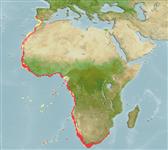Common names from other countries
Classification / Names / Names
Common names | Synonyms | Catalog of Fishes (gen., sp.) | ITIS | CoL | WoRMS
Environment: milieu / climate zone / depth range / distribution range
Ecology
Benthic; depth range 25 - 774 m (Ref. 104453). Tropical; 39°N - 37°S, 18°W - 33°E
Eastern Atlantic and Western Indian Ocean: Morocco, Gibraltar Strait to Durban, South Africa.
Length at first maturity / Size / Weight / Age
Maturity: Lm ? range ? - ? cm Max length : 14.0 cm TL male/unsexed; (Ref. 434)
Occurs at depths of 50 to 450 m with juveniles common at 50 to 100 m (Ref. 8). Inhabits sand and mud bottoms. Feeds on benthic organisms (polychaetes, small crustaceans and mollusks (Ref. 434).
Life cycle and mating behavior
Maturity | Reproduction | Spawning | Eggs | Fecundity | Larvae
Members of the order Decapoda are mostly gonochoric. Mating behavior: Precopulatory courtship ritual is common (through olfactory and tactile cues); usually indirect sperm transfer.
Holthuis, L.B. 1980. (Ref. 8)
IUCN Red List Status (Ref. 130435)
CITES status (Ref. 108899)
Not Evaluated
Not Evaluated
Human uses
Fisheries: minor commercial
| FishSource |
Tools
More information
Age/SizeGrowthLength-weightLength-lengthMorphologyLarvaeAbundance
Internet sources
Estimates based on models
Preferred temperature
(Ref.
115969): 9.2 - 15.9, mean 11.9 (based on 131 cells).
Vulnerability
Low vulnerability (10 of 100).
Price category
Unknown.
